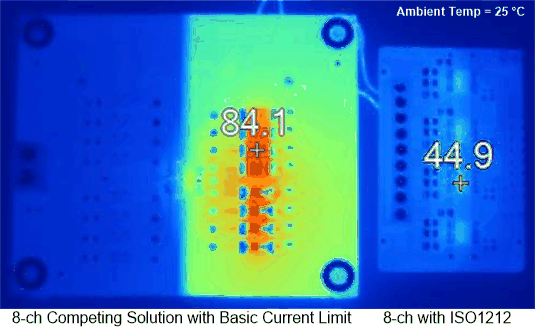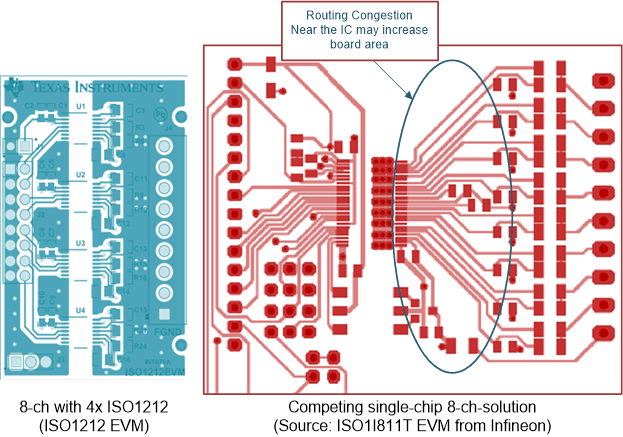SLLA370C August 2017 – November 2024 ISO1211 , ISO1212 , ISO1228 , ISO7710 , ISO7720 , ISO7730 , SN65HVS880 , SN65HVS881 , SN65HVS882 , SN65HVS883 , SN65HVS885
Digital Input Modules
Digital Input (DI) modules are used in Programmable Logic Controllers (PLCs) and Motor Drives to receive 24V digital inputs from field sensors and switches. Isolation is used to manage ground potential differences. The input signal is interpreted as a logic high or low using a voltage comparator with hysteresis. Some form of current limit is also implemented to avoid excess current draw from the 24V inputs; power dissipation is a critical concern in high-density compact multichannel designs.
The IEC 61131-2 standard for programmable controllers specifies three different types of digital input receivers: Types 1, 2, and 3. Ideal implementations for Type 3 need to draw as close to 2mA as possible in the ON-state, and have voltage transition thresholds between 5V and 11V.
 Figure 1 Traditional DI Modules a)
Basic Current Limit b) More Accurate but Complex Current Limit
Figure 1 Traditional DI Modules a)
Basic Current Limit b) More Accurate but Complex Current LimitCommon Digital Input Implementations
Figure 1 shows the two most common implementations of Digital Input receivers in use today. In the first case shown in Figure 1 (a) the voltage thresholds are set by resistors R1 and R2, and R2 serves as a basic current limit. Such an implementation for Type 3 inputs can easily draw up to 12mA at 32V input. The second implementation shown in Figure 1 (b) uses several discrete components (9 to 15) to implement a better current limit and controlled voltage thresholds. In this case, for Type 3, the current draw can be as high as 6mA across temperature depending on the design. In both cases, the current limit is much higher than the ideal current limit of 2mA for type 3 inputs. A Schmitt trigger buffer is usually needed after the optocoupler to provide hysteresis for noise immunity.
 Figure 2 One Channel of a Digital Input
Module With ISO1211
Figure 2 One Channel of a Digital Input
Module With ISO1211New Designs for Digital Input Modules
Texas Instruments' ISO1211 1-channel, ISO1212 2-channel, and ISO1228 8-channel devices are isolated digital input receivers with integrated current limit, compliant to IEC 61131-2 Type 1, 2, and 3 characteristics. The ISO1211 is designed for channel-to-channel isolation and the ISO1212 and ISO1228 are designed for multichannel designs. Figure 2 shows the implementation of one channel of a Digital Input module with ISO1211. The resistor RSENSE controls the current limit, and the resistor RTHR, the voltage transition thresholds. The recommended values of RSENSE and RTHR and application circuits for multichannel and other scenarios are provided in the ISO121x product data sheet. The ISO121x simplifies system design by integrating an accurate current limit, voltage comparator with hysteresis, reverse polarity protection and isolation, while not needing field-side power. For Type 3 characteristics, ISO121x limits the input current draw to < 2.5mA, a factor of 5 × lower than traditional approaches.
 Figure 3 Board Temperature Comparison:
Traditional Design vs ISO1212
Figure 3 Board Temperature Comparison:
Traditional Design vs ISO1212Compared to traditional approaches using optocouplers, designing with ISO121x has the following advantages:
- Lower Power Dissipation: The precise current limit in the ISO121x can reduce the current drawn from digital inputs by up-to a factor of 5 reducing power dissipation and board temperature. As shown in Figure 3, a traditional design can heat up to 84°C during a room temperature test, where as ISO121x-based design is much cooler at 45°C.
- Smaller boards and modules : ISO121x-based designs reduce component count leading to smaller boards. Lower power dissipation also allows packing more channels in a smaller module.
- Simplified System Design : With ISO121x, the IEC 61131-2 input characteristics, current limit and isolation are provided by the data sheet. No additional Schmitt trigger buffer is needed. This simplifies system design.
- High Speed Operation : ISO121x offers 4Mbps data rate and 150ns latency - allowing much faster interfaces than general purpose optocouplers.
Multichannel Single-Chip Solutions
Figure 4 compares the layout of a design with four ISO1212 devices with a competing 8-channel single-chip solution. The Y-dimension of the board is limited by the placement of the input screw terminals and connectors. However, the X-dimension is higher for the 8-channel single-chip solution. This is because of additional space taken due to routing congestion close to the IC. Conversely, since ISO1212 has only two channels, there is more flexibility in placing the IC closer to the input terminals resulting in much simpler routing, leading to a smaller design.
 Figure 4 Layout of ISO1212-Based Design
vs Competing 8-Channel Single-Chip Solution
Figure 4 Layout of ISO1212-Based Design
vs Competing 8-Channel Single-Chip SolutionOther advantages of ISO121x-based design over some multichannel serializer devices include:
- No need for field side power supply: This saves cost on connectors and terminals for the 24V field side supply as well as the corresponding surge protection.
- Channel independence: Damage to one channel on the field side (say, due to short circuit) does not impact any of the other channels.
- Higher speeds: Serialization in multichannel devices limits speeds to <20kHz, while ISO121x devices can support up to 2MHz clocking.
Design for Surge, EFT and ESD Immunity
The ISO12xx devices have been designed for Surge, EFT and ESD immunity according to IEC 61000-4-x standards. Please refer to the application section of the product data sheet for design, and layout guidelines to achieve the best transient immunity.
Conclusion
The ISO1212, ISO1211, and ISO1228 devices bring a modern design to Digital Input Modules, integrating IEC 61131-2 input characteristics, voltage comparator with hysteresis, a precise current limit and galvanic isolation in a small package. Modules designed with ISO121x have lower power dissipation, allow higher channel density, are compact and simple to design compared to traditional designs.
| Device | Optimized Parameters | Performance Trade-Off |
|---|---|---|
| SN65HVS880 | 8-channel digital input serializer | Non-isolated, 3.6mA current limit, Needs field side supply |
| SN65HVS885 | 8-channel digital input serializer | Non-isolated, 3.6mA current limit, Needs isolated DC-DC |